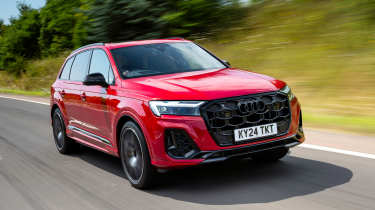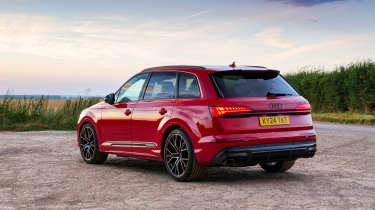Audi SQ7 review – seven seats and BMW M2 pace
Audi’s latest SQ7 promises to be a do-it-all family bus, mixing a 500bhp V8 with three-row seating. How does it stack up against BMW’s X7 M60i?
When Audi launched the original Q7 back in 2006, it differed from most other luxury SUVs in one key regard – an unapologetic emphasis on family friendliness. This wasn’t just due to its standard-fit seven seats, but also a relatively low ride height, disinterest in off-road capability and long wheelbase. But it wasn’t all sensible – you’ll surely remember the near £100k, 493bhp Q7 V12 TDI, which terrorised private school car parks and outsprinted Porsche Caymans in period.
Unsurprisingly (and probably for the best), the current Q7 doesn’t come with a V12, but the latest SQ7 is even more powerful than the old diesel-drinking bruiser. As a three-row hot rod to rival the likes of the BMW X7 M60i, it gets a 500bhp twin-turbo V8 and a host of advanced chassis tech, plus a fresh design that came as part of a facelift in 2024.
The latest round of updates aren’t transformative, but on paper the SQ7 still has all the tools and tricks you’d expect from a modern performance SUV, including active roll stabilisation, a torque vectoring rear differential, four-wheel steering and adaptive air suspension. It promises everything as a luxurious, performance-oriented SUV and family hauler – but can it deliver?
Audi SQ7 in detail
- Engine, gearbox and technical highlights > The 4-litre twin-turbo V8 is shared with other Volkswagen Group products, and there’s an array of clever chassis systems to harness it
- Performance and 0-60mph time > Hitting 62mph in just over 4sec flat, the SQ7 has most hot hatches – and some serious sports cars – covered off the line
- Ride and handling > Refined and handles its imposing bulk well, but far from involving
- Interior and tech > Fit and finish is hard to fault, but the SQ7’s cabin is more clinical than luxurious
- MPG and running costs > A 500bhp V8 and 2.2+ ton kerb weight isn’t a recipe for efficient motoring, and consumables will be pricey
- Design > It isn’t pretty and it isn’t subtle, but the SQ7 is big, imposing and makes an impact on the road
Price and rivals
In terms of price, the SQ7 is positioned in something of a sweet spot compared to its rivals. It might not have the on-paper numbers of the biggest, baddest performance SUVs, but it’s more rounded than many of them. It’s more deft than a Mercedes GLS, feels more nimble than the BMW X7, and while those are both available with more powerful V8 engines, they’re much pricier so-equipped.
The entry point to the SQ7 range is the £95,730 Black Edition, with prices rising to £114,080 for the kitted-out Vorsprung model. BMW’s X7 M60i is a few bhp up and is more sumptuous inside (if a little chintzy for some tastes), but starts from £113,055. The Mercedes-AMG GLS63 costs an enormous £153,595 and thinks of itself as a further class up, but its driving experience and levels of build quality question that notion.





